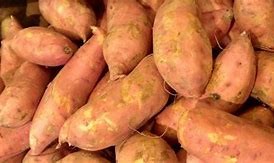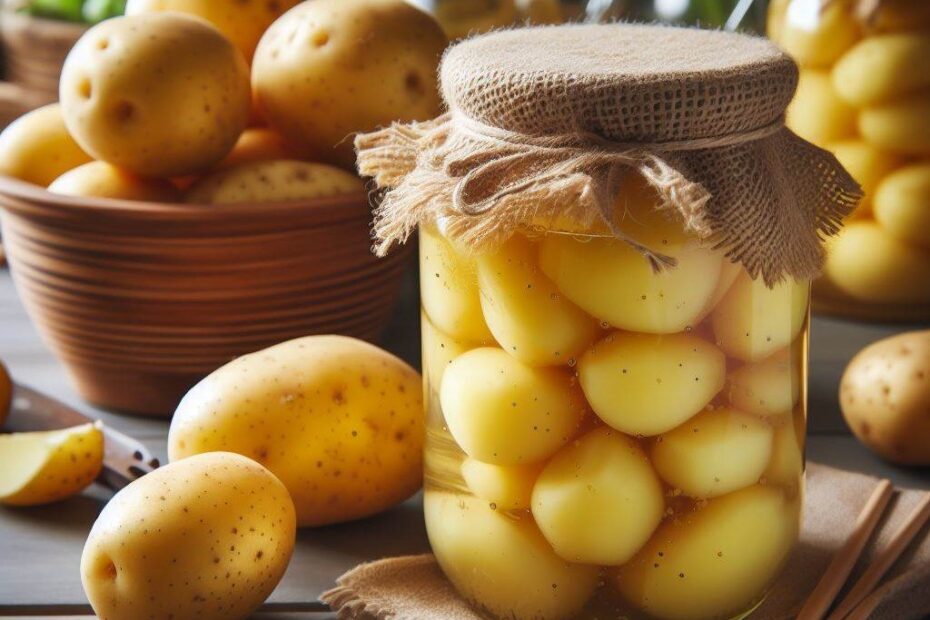Searching for an easy way to make delectable fermented potatoes? You’re not the only one! Fermented potatoes can add a yummy taste and texture to your meals. However, the idea of making them can be scary. We have the best tips and tricks for you!
Now you can enjoy homemade fermentation just like everyone else!
Introduction To Fermented Potatoes
Fermented Potatoes: A Comprehensive Guide!
Fermented potatoes are an incredible way to preserve them and boost their nutrition. This guide provides you with all the details you need to know about fermented potatoes.
- Benefits: Fermenting potatoes increases their nutritional value and makes them simpler to digest. It also helps keep them for a longer time.
- Making Fermented Potatoes: To make fermented potatoes, you need some simple ingredients like water, salt, and potatoes. The process involves washing and slicing the potatoes, mixing them with saltwater brine and leaving them to ferment for a certain period.
- Ways to Eat Fermented Potatoes: When you’ve successfully fermented your potatoes, there are many ways to use them. Examples include using them as toppings on salads or sandwiches, or adding them to dishes like casseroles or stews.
- Best Storage: Proper storage is vital for fermented food items like potatoes. Store your fermented potatoes in an airtight container in a cool place away from direct sunlight.
Each batch of fermented potatoes may differ depending on factors such as temperature and humidity; make sure to monitor your fermentation and modify accordingly.
The Benefits Of Fermented Potatoes

Fermenting potatoes has special benefits for nutrition and health. It boosts the vitamin, enzyme, and amino acid levels. Plus, the bioavailability of micronutrients in potatoes has improved.
Fermenting also boosts gut bacteria, aids digestion, and reduces harmful components like solanine. Plus, it has anti-inflammatory properties that reduce inflammation in the body.
So, why not give it a go and experience the amazing health benefits? Get your taste buds ready for a delicious treat!
The History Of Fermented Potatoes
Fermenting potatoes has been around for centuries. In Northern Europe, people stored them in pits dug in the ground or barrels filled with water. This was an efficient way of preserving potatoes over the winter when fresh produce was scarce.
Fermentation turns starch into lactic acid, which stops the growth of bad bacteria and fungi. It also makes minerals more bioavailable. Plus, it’s thought that fermented potatoes are more nutritious than raw ones.
Careful monitoring of temperature and air flow is a must when fermenting potatoes. They should be kept at a cool temperature of 50–70°F (10–20°C).
Archaeologists have even discovered 2,000-year-old fermented potatoes at Andean ruins in South America. This shows us that fermenting potatoes has been an important preservation technique across many cultures throughout history. So, get fermenting today!
How To Make Fermented Potatoes

Fermenting potatoes is an old-fashioned way of preserving them while adding a tangy flavor. Here’s a quick guide for fermenting potatoes at home with easy-to-find ingredients.
- Slice peeled potatoes into thin pieces evenly.
- Put slices into a jar or glass container, leaving an inch of room on top.
- Add water, salt and whey, enough to submerge the slices completely.
- Cover loosely and leave to ferment at room temperature for a few days until bubbles appear.
Maintain cleanliness and use good-quality ingredients for perfect potatoes. Try adding spices like black pepper or red pepper flakes for extra flavor, but don’t overdo it.
A chef once shared his experience ‘discovering’ fermented foods while travelling in South America. He tasted crunchy golden discs made from fermented potato pulp called Chuño. Uncover the root of deliciousness with these various types of fermented potatoes!
The Different Types Of Fermented Potatoes
Exploring the variety of fermented potatoes is key. Let’s discuss the kinds! Table 1 shows some unique types and their features.
Classic Sauerkraut-style, Kimchi-style, Lacto-Fermented Potato Salad, and Pickled Potato Slices. Each has its own flavor, texture, and color.
Fresh ingredients, clean utensils, and good hygiene are essential for good quality. Organic vegetables are best, and avoid chemicals or preservatives.
For yummy fermented potatoes, use a good starter culture, control the temperature and duration of fermentation, and store in a cool, dark place.
Get the fermentation going; your taste buds will thank you!
| Type | Flavour | Texture | Colour |
| Classic Sauerkraut-style | Tangy and salty | Crunchy | Light yellow |
| Kimchi-style | Spicy and sour | Slightly soft | Orange-red |
| Lacto-Fermented Potato Salad | Creamy and tart | Soft | Light yellow |
| Pickled Potato Slices | Tangy and salty | Crunchy | Pale yellow |
Lacto-Fermented Potatoes
Fermenting potatoes can be a scrumptious addition to your meals! This process involves lacto-fermentation, where bacteria break down sugars and starch, resulting in lactic acid that gives them a tangy taste.
Here’s how:
- Pick the correct potato.
- Wash and peel them.
- Cut them up into small pieces or slices.
- Add salt and seasonings of your choice.
- Pop them in a jar with water and let them ferment for a few days.
Plus, they keep for longer and retain most of their nutrients during fermentation!
Tip: Try different spices and herbs to create unique flavors. Transform your potatoes into funky fermented chips that’ll have you wondering why you didn’t try this before!
Fermented Potato Chips

Make potatoes unique by fermenting them! Here’s how:
- Pick fresh, high-quality potatoes
- Slice thinly and evenly using a mandolin or sharp knife
- Mix a brine of water, salt, garlic and spices
- Soak potatoes in brine for 24+ hours for fermentation
- Dry the potatoes pre-frying or baking
- Store chips in an airtight container
Experiment with rosemary, paprika, and other seasonings for more flavor. Get creative with recipes!
Tip: Use a food dehydrator for super-crispy chips. Enjoy!
Fermented Sweet Potato Recipe

Fermenting Sweet Potatoes is becoming a hot dish around the globe. This ancient Korean cuisine is easy to prepare and adds a delicious tangy flavor.
Here are the steps:
- Wash and peel the potatoes, making sure they are all uniform in size.
- Sprinkle salt over the cut potatoes. Place them in a glass jar and fill it with water until all the potatoes are submerged.
- Cover the jar with a cheesecloth or paper towel and leave it at room temperature for 2–3 days. The fermentation process takes 3-5 days, or until you see bubbles in the water.
For more flavor, add spices like cinnamon sticks or red pepper flakes before sealing the lid.
This dish is great for gut health and can be used to top salads or eaten as is. It dates back centuries in Korean cuisine and is passed down through generations. Try fermenting potatoes for a probiotic-rich snack!
Fermented Raw Potatoes
For fermenting raw potatoes, follow these tips and tricks:
- Peel and slice the potatoes thinly.
- Then make a brine solution with water and salt, and submerge the sliced potatoes.
- Let them sit at room temperature for a few days until they turn tangy and pickled.
- Clean all utensils before use. Glass jars are best to avoid chemical reactions from metal containers.
- Add spices or herbs for extra flavor.
- Ferment at a temperature between 60 and 70°F for optimal results.
- Check for mold growth regularly.
- Use an airlock lid or cover with cheesecloth to allow air flow but prevent contamination.
- Rinse and dry the fermented potatoes for extra texture.
These pickled potatoes are great for salads, soups, and sandwiches. Patience is key, so give it time!
A farmer once shared her story of leaving a jar of raw potatoes in her pantry; they fermented into delicious pickled potatoes that she used regularly in her meals.
From then on, she purposely fermented her raw potatoes each year as a delicious addition to her kitchen. Transform your kitchen into a distillery with just a few fermented potatoes!
From Fermented Potatoes To Vodka
Potatoes can be transformed into vodka via a complex fermentation and distillation process.
Step one is to break down the starches into sugars. Then, the liquid produced can be distilled to make high-proof alcohol. The resulting spirit can then be refined and flavored.
Fermenting potatoes needs cleanliness and temperature regulation, as any contamination or changes can damage the alcohol. The fermentation time may differ based on temperature, yeast strain, and alcohol content.
I once encountered a potato farmer who also ran a distillery, where he used traditional methods to make premium vodka out of his potatoes.
He emphasized the significance of using top-notch potatoes and precisely controlling each step to guarantee consistency and quality.
The Benefits Of Eating Fermented Potatoes
Fermented potatoes are an excellent source of nutrients that can be stored for a long time. They are not only scrumptious but also bring numerous health benefits, such as:
- Enhanced Digestion
- Immune System Boost
- Reduced Inflammation
- Assisting in Weight Loss
It contains probiotics that foster healthy bacteria in the gut, thus improving digestion.
Furthermore, they offer essential vitamins and minerals that help the body’s immunity and reduce inflammation, protecting against chronic illnesses.
Additionally, eating fermented potatoes can lead to weight loss as they make one feel fuller for longer.
Fermenting potatoes is a unique way of preparing them and adds to their nutritional value. It is also an easy method to save and store them without compromising on taste.
Tip: Red potatoes are best for fermenting, as they retain their texture after fermentation.
Fermented Potatoes And Weight Loss
Fermented potatoes? A great addition for weight loss! The fermentation process increases nutrients and decreases calories. Thus, it helps with healthy eating. Combined with reduced calorie intake and physical activity, it will lead to weight loss.
Consume fermented foods regularly. This will help convert food into energy while decreasing body fat. Fermented potatoes can maintain blood sugar levels, which is important for those with diabetes or pre-diabetes.
Include fermented potatoes in your diet for better digestion of carbs and fibers. This can reduce bloating, inflammation, fatigue, and constipation. It can also reduce nausea, cramps, and feverishness. All this can decrease the chances of gaining weight.
For a better taste, try different spices like dill pickles, soaked garlic butter sauce, and chopped green onions and parsley. This can open up new possibilities and encourage prolonged habit formation. So why not try out the “horror” of fermented potatoes?
How To Ferment Cabbage: Easy Step-by-Step Guide ⇒ READ MORE
The Side Effects Of Fermented Potatoes
- Fermented potatoes can have diverse undesirable effects. Commonly, digestive problems and bacterial infections occur. Food poisoning can also arise, leading to serious sickness and hospitalization.
- Keenly monitor the fermentation process, as it may create deadly toxins that are harmful to health. Do not consume improperly fermented potatoes, especially if you have a weak immune system or an allergy.
- Remember to cook the fermented potatoes before eating; they cannot be eaten raw due to the danger of bacterial contamination. Botulism infections may occur if toxins enter the human body via stomach cuts.
- Fermentation has been used for centuries to preserve food. In ancient times, fermenting vegetables and fruits was popular since it lasted longer and was easier to store than fresh produce. However, consuming unprofessionally fermented food may result in unwanted outcomes.
Frequently Asked Questions
What are fermented potatoes?
Fermented potatoes are a traditional food that is made by allowing potatoes to undergo a natural fermentation process. This process involves the growth of beneficial bacteria that break down the sugars and starches in the potatoes, creating a tangy and slightly sour taste.
How do you make fermented potatoes?
To make fermented potatoes, start by boiling the potatoes until they are soft but not mushy. Let them cool before slicing them into thin pieces. Place the potato slices in a clean jar and cover them with water, leaving some space at the top. Add salt to the jar to encourage fermentation, and let it sit at room temperature for 3–5 days.
Can I reuse the brine from previous batches of fermented potatoes?
Yes, you can reuse the brine from previous batches of fermented potatoes. The brine contains beneficial bacteria that can help kickstart the fermentation process for your next batch. Make sure to filter out any potato bits or debris before using the brine.
How do I know if my fermented potatoes have gone bad?
Fermented potatoes should have a slightly sour smell and taste. However, if they have foul odors, a slimy texture, or an unusual color, it’s likely that they have gone bad. Trust your senses and dispose of any potatoes that don’t seem right.
What are some tips for making the best fermented potatoes?
To make the best fermented potatoes, use high-quality potatoes that are free of blemishes or mold. Make sure to clean your jar and utensils thoroughly before starting the fermentation process. Use a ratio of 1 tablespoon of salt per quart of water to encourage fermentation. Keep the jar out of direct sunlight and at a temperature between 60 and 70°F for best results.

